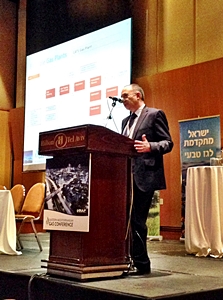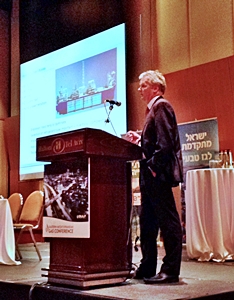EMGC ’14: Gas infrastructure expansions require reliability, diversity — experts
3/12/2014 12:00:00 AM
By ADRIENNE BLUME
Managing Editor
TEL AVIV, Israel -- Gulf Publishing Company's second annual Eastern Mediterranean Gas Conference (EMGC) continued on Wednesday with a session dedicated to infrastructure requirements, developments and reliability.
 Gas plant design options. Jon Lewis, the global director of gas processing for WorleyParsons, spoke about the diversity of gas processing plants within the industry (photo 1).
Gas plant design options. Jon Lewis, the global director of gas processing for WorleyParsons, spoke about the diversity of gas processing plants within the industry (photo 1).Mr. Lewis gave brief reviews of various gas composition characteristics, thermodynamic technologies for gas processing, and the basic operational flow for a typical gas processing plant's main functions—acid gas removal, dehydration and natural gas liquids (NGL) removal.
He then discussed a number of variables that impact and require adaptations of these processing functions, and gave examples of specific plants with varying configurations, such as the San Juan gas plant and the Whitney Canyon gas plant, both of which use molecular sieves.
Meanwhile, the Hannibal gas plant features a combination BTX and glycol removal process that is an integral feature of its design. The CATS gas plant has minimum liquids recovery and no CO2 removal, which Mr. Lewis noted is not an optimal design option for today's gas plant operations.
The Point of Ayr gas plant has no air coolers because it is located next to a vacation resort, and noise minimization is a priority. Meanwhile, the high-reliability Langeled gas plant receives 2.5 Bcfd of fully treated gas at various pressures, and its primary function is to separate out inadvertent liquids.
Mr. Lewis then spoke about a new Israeli gas plant that will likely be built between Tel Aviv and Haifa. This plant must accommodate specific CAPEX, OPEX, flexibility, operability, and inherently safer design parameters. Many of these design options are found in presently operating gas plants and can be adapted for use in a greenfield Israeli gas plant.
 Risk assessment for FLNG design. Next, DNV GL Vice President Richard Whitehead spoke about the risks and key issues involved in subsea installation and floating liquefied natural gas (FLNG) projects (photo 2).
Risk assessment for FLNG design. Next, DNV GL Vice President Richard Whitehead spoke about the risks and key issues involved in subsea installation and floating liquefied natural gas (FLNG) projects (photo 2).Primary risks include process safety and environmental concerns, OPEX and CAPEX risks, and technical considerations. For FLNG in particular, several specific risks must be considered.
These risks include hydrocarbon fire and explosion (approximately 50% of risk) as well as non-process hazards. The risk profile for every project is different, although risks are generally higher for an FLNG vessel than for an offshore platform. The layout of the vessel is particularly critical, Mr. Whitehead said, due to the complexity of the processes required for FLNG projects.
More specifically, hydrocarbon risks include explosion, pool fire, jet fire, cryogenic spill, and rapid phase transition. Explosion risks tend to dominate, so living quarters and safety shelters must be carefully located, and explosion-proof barriers should be considered for these structures.
Stainless steels, special coatings and concrete can help mitigate cryogenic spills, and the locations of solid floors and drainages or breakaways must be carefully chosen to contain or drain cryogenic spills.
DNV GL research on FLNG shows that it is advantageous to understand the influences in the explosion loads as early as possible, both to help the design and to ensure a high level of process and worker safety.






Comments